Introduction
The DJI Phantom 3 Professional is a cutting-edge quadcopter designed for high-quality aerial photography and videography. Equipped with advanced flight control technology, a stabilized 4K camera, and intelligent navigation systems, the Phantom 3 Professional is crafted to deliver exceptional performance for both professional filmmakers and hobbyist drone enthusiasts. With its FCC certification under ID SS3-WM3231507, this drone complies with stringent US electromagnetic interference standards, making it fully legal for sale and use within the United States.
FCC certification (FCC ID SS3-WM3231507) ensures that the Phantom 3 Professional adheres to regulatory requirements concerning RF emissions, safety, and interference. This compliance not only confirms the drone’s reliability and safety standards but also facilitates consumer trust. In this detailed analysis, we explore the Phantom 3 Professional’s key features, delve into its internal components through a comprehensive teardown, analyze its wireless specifications, and highlight insights derived from its FCC filings.
Key Features & Specifications
The DJI Phantom 3 Professional boasts an array of impressive features and technical specifications:
Key Features:
- Return to Home (RTH): Includes Smart RTH, Low Battery RTH, and Failsafe RTH for enhanced safety.
- 12 Megapixel Photos: High-resolution still photography capabilities.
- Vision Positioning System: Ensures precise indoor hovering even without GPS signals.
- DJI Intelligent Flight Battery (4480 mAh): Advanced battery management for extended flight times and reliability.
- Next-Generation Flight Controller: Provides an intuitive, stable flight experience and stores flight data.
- DJI Lightbridge HD Video Downlink: Real-time HD video transmission with minimal latency.
- 4K Video Recording: Ultra-high-definition video capture for professional-grade footage.
- Dynamic Home Point: Updates the return location dynamically during flight for optimized safety.
Technical Specifications:
- Camera: 4K video, 12 megapixel stills.
- Battery: 4480 mAh DJI Intelligent Flight Battery.
- Mobile Compatibility: Android 4.1.2 or later, iOS 8.0 or later.
- GPS Module: Accurate positioning and home point recording.
- Low Battery RTH: Automatic return triggered by battery status and flight conditions.
- Failsafe RTH: Activates if remote controller signal is lost for over 3 seconds.
- Flight Modes: P mode (Positioning), A mode (Attitude), F mode (Function).
- Bluetooth: Integrated (detailed specs not disclosed).
Operating Frequencies:
| Frequency Range (GHz) | Output Power (mW) | FCC Rule Part |
|---|---|---|
| 2.4065-2.4765 | 612 | 15CMO1 |
Technology Deep Dive
The Phantom 3 Professional primarily utilizes the 2.4 GHz frequency band, a widely used spectrum for Wi-Fi and Bluetooth connectivity. This frequency choice provides an optimal balance of range and data throughput, suited for real-time HD video streaming and responsive control commands. Operating at 612 mW power output, the drone achieves considerable communication range while adhering to FCC regulations, ensuring minimal interference with other devices.
This wireless configuration supports reliable video transmission via DJI’s proprietary Lightbridge technology, offering low-latency HD streaming. The chosen frequency band and power level balance performance, battery efficiency, and regulatory compliance, making the Phantom 3 Professional ideal for professional applications demanding stable and uninterrupted wireless communication.
In-Depth Internal Component Analysis / Teardown
The Phantom 3 Professional’s internal hardware showcases DJI’s meticulous engineering and attention to detail. Below is a detailed examination of key internal images:
The main PCB prominently features an Ambarella A9-A1-RH SoC, known for its powerful video processing capabilities, essential for handling 4K footage. Adjacent Elpida and Nanya memory chips provide necessary DRAM and NAND flash storage, respectively, supporting rapid data buffering and firmware storage. Texas Instruments components indicate robust power management circuitry, ensuring stable power distribution. The multi-layered PCB with dense routing demonstrates high-speed signal integrity optimization, reflecting DJI’s commitment to performance and reliability.
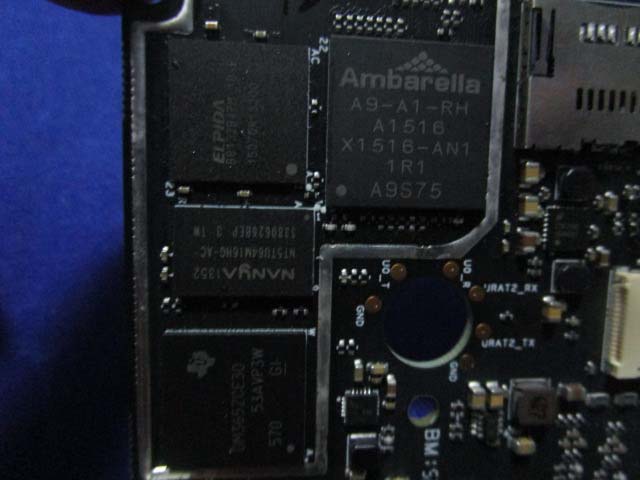
A dedicated imaging PCB hosts a central CMOS image sensor labeled FP1520, integral for capturing high-resolution visual data. The compact design with multiple grounding vias emphasizes signal integrity, ensuring high-quality image acquisition. Mounting holes secure the sensor assembly, underscoring DJI’s focus on durability and stable image capture in challenging flight conditions.
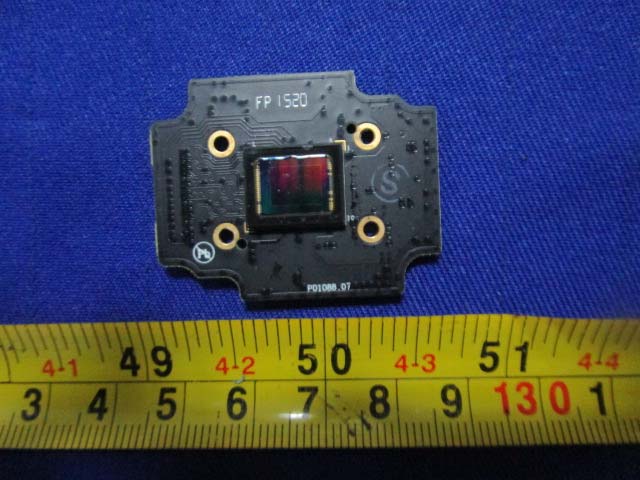
An Analog Devices IC, likely an ADC, paired with an Altera FPGA, highlights sophisticated signal processing and customizable logic operations. The metal shielding present underscores careful EMI/RFI management, crucial for maintaining signal clarity and minimizing interference during flight operations.
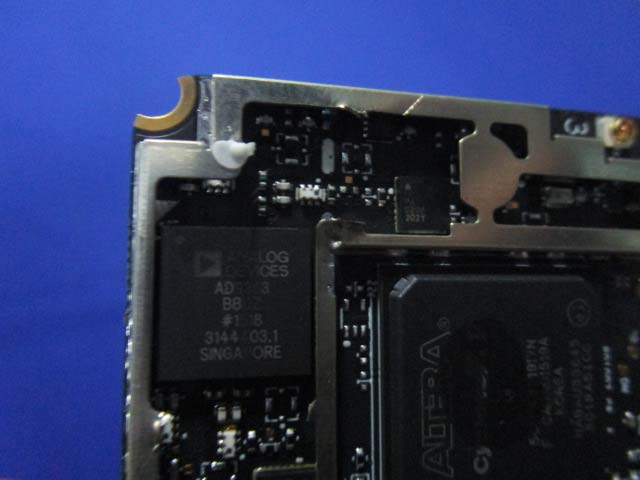
Another Altera FPGA prominently appears, reaffirming DJI’s reliance on flexible, powerful processing solutions for real-time video handling and flight control tasks. The PCB’s dense layout and shielding further indicate attention to electromagnetic compatibility and performance stability.
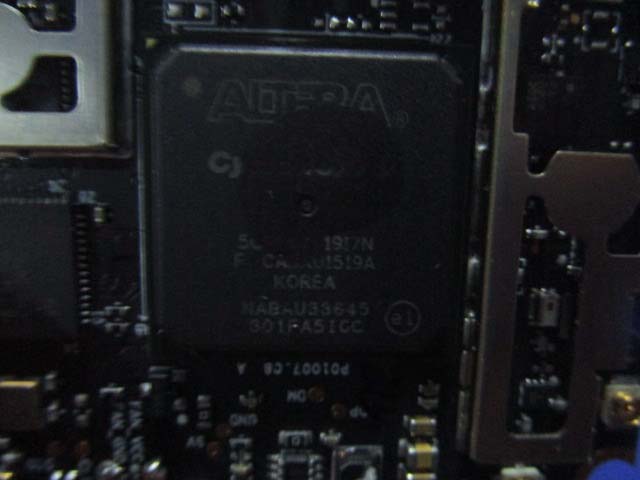
A compact GPS module labeled “GPS-M2 V1.0 1409” with DJI branding indicates specialized GPS signal processing. The simple, circular PCB design and metal shielding ensure reliable GPS functionality, crucial for navigation and return-to-home features.
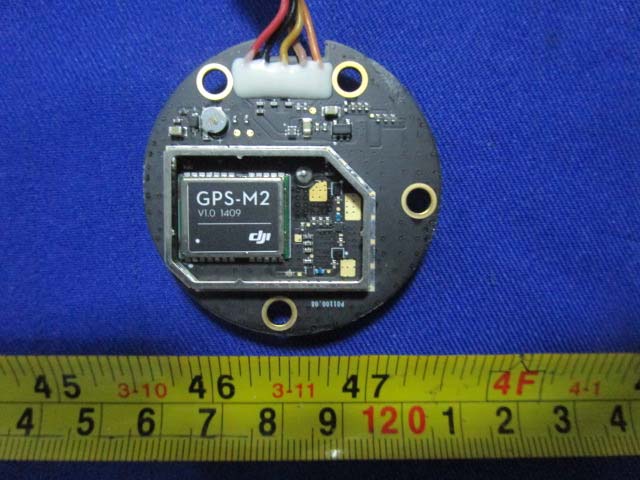
The GPS antenna module employs a ceramic patch antenna, optimized for the GPS L1 frequency. Its straightforward design prioritizes robust GPS signal reception, vital for accurate drone positioning and stable flight performance.
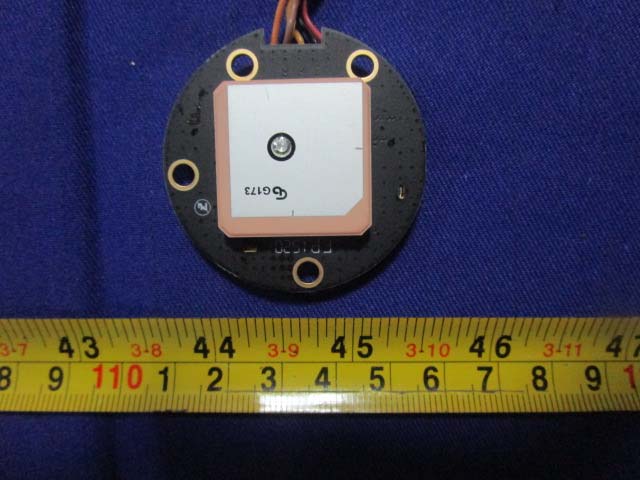
Regulatory Insights & FCC Filing
FCC certification under ID SS3-WM3231507 confirms the Phantom 3 Professional’s compliance with US electromagnetic interference and RF safety standards. FCC filings typically include EMC test reports, RF exposure assessments, product manuals, internal photographs, schematics, and technical block diagrams. The Phantom 3 Professional’s user manual emphasizes its advanced features, including its Vision Positioning system, Intelligent Flight Battery, and enhanced DJI Lightbridge HD video technology, underscoring the drone’s high-end capabilities.
Potential Use Cases & Target Audience
The Phantom 3 Professional is particularly suited for:
- Professional Videographers: Capturing cinematic aerial footage in 4K, leveraging its stabilized gimbal camera and HD video downlink for real-time monitoring.
- Inspection and Survey Professionals: Utilizing precise GPS and Vision Positioning for accurate aerial inspections of infrastructure, real estate, or agricultural land.
- Drone Enthusiasts and Hobbyists: Enjoying advanced flight features and intelligent safety systems for recreational flying with professional-grade results.
Conclusion
The DJI Phantom 3 Professional (FCC ID SS3-WM3231507) combines sophisticated technology, robust build quality, and regulatory compliance, positioning itself as a premier drone for both professional and recreational users. Its internal components reveal a commitment to high-performance video processing, precise navigation, and reliable wireless communication. With its proven compliance and advanced capabilities, the Phantom 3 Professional remains a standout choice in the competitive drone market.